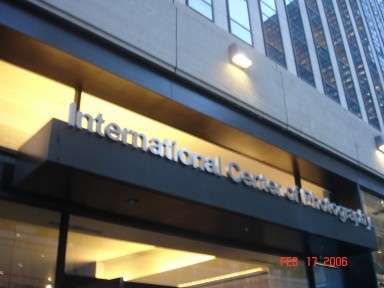
Below is an interview we made with the ICP, located in Manhattan and is dedicated to the understanding and appreciation of photography. For those of you who are interested in the power and evolution of photography, this place is for you.
1) Can you tell us a little about the history and the mission of ICP and how the public benefits from this mission?
The International Center of Photography (ICP) was founded in 1974 by noted photojournalist Cornell Capa. Originally housed in a landmark mansion on Fifth Avenue and 94th Street, ICP is now located on a dynamic two-part campus in Midtown Manhattan. It stands among the nations foremost museums dedicated to preserving the past and ensuring the future of the art of photography. One of the largest facilities of its kind, the Center offers changing exhibitions of the finest works by some of the most talented photographers and artists in the world. With over fifteen changing exhibitions each year, ICP presents an extensive array of historical and contemporary works, revealing the power and diversity of the medium from documentary photography to digital imaging.
The School of the International Center of Photography fosters study of the history, techniques, aesthetics, and practices of photography in a wide range of courses. Continuing education classes, community programs, lectures, symposia, digital media classes, full-time certificate programs in photojournalism and general studies in photography, and Masters programs in conjunction with NYU and Bard are among the offerings of the ICP Education department.
There are so many “publics” that benefit from what ICP offers – If you want to make pictures – take pictures – look at pictures – or learn about what goes into the making and taking – It’s all here at ICP …
2) What makes ICP different than other photography institutions, especially considering that it’s both a museum and a school?
ICP is the only New York City museum devoted exclusively to all aspects of the photographic medium. As such it is a uniquely comprehensive institution—one whose exhibitions, publications, collections, and educational programs work in dynamic and complementary fashion. ICP’s mission is to present photography’s vital and central place in contemporary culture, and to lead in interpretation of issues central to its development. It does this by embracing all aspects of the medium: from aesthetics to technique, from the 19th century to the present, from master photographers to newly emerging talents, and from documentary photography to digital imaging. By constantly re-creating relationships between the images in the galleries, the courses being offered, and the public programs being presented, ICP strives to foster the appreciation of photography as both an artistic and educational endeavor. And it is this special synergy that provides the institution’s increasingly diverse audiences with ever-expanding opportunities for personal and professional growth and enjoyment.
3) Besides photography exhibitions, do you host events or exhibitions that involve the moving image, film or video projects?
In conjunction with its exhibitions, ICP hosts a number of public programs, which in the past have included film screenings. For example, programming in conjunction with the spring 2007 exhibition Louise Brooks and the New Woman in Weimar Cinema included a public screening of the film Pandora’s Box at the School of the International Center of Photography. Partnerships surrounding such programs have been developed with area independent film theatres Film Forum and IFC Center, presenting relevant art, independent, and feature films.
Many of ICP’s exhibitions include traditional photography and video installations, showing the range of work that can be brought together under the umbrella of photography. Video is often integratedn into exhibitions, offering historical perspective, contextual information, or supplemental work done by the photographers.
4) You have a very extensive and detailed website that presents all the facets of your institution in an eloquent way. In your opinion, what are some of the strengths of the internet and the new media in terms of presenting an artist’s work or an organization’s projects?
Exhibitions provide the direct experience of the artwork, artifact or temporal experience in the case of a video or film. The website provides context at various depths that can rarely be incorporated into an exhibition. While a book can offer precision, it does not allow for mutability or continual updates. The web brings together both broader context (and content) and the ability to continually revise and review. It can also become a more collaborative space, which ICP may consider adding in the future.
5) How would you describe the relationship between the still image and the moving image, especially now that we are in the digital era?
ICP has paid attention to the time-based image for a very long time. Not only has the organization presented video for two decades, it organized one of the first noted digital media exhibitions in the 1990s. Today many photographers move among video and the still image. Our next major exhibition coming up this summer (2008) gives equal status to both photography and video from Japan. New digital presentation and storage techniques also make it more likely to present video within both a gallery and a research space by using media servers in the future rather than conventional tape or DVD.
For more information on ICP, please go to
www.filmannex.com/EvanKingsley
Interview by Eren Gulfidan -
www.filmannex.com/Eren%20Gulfidan

